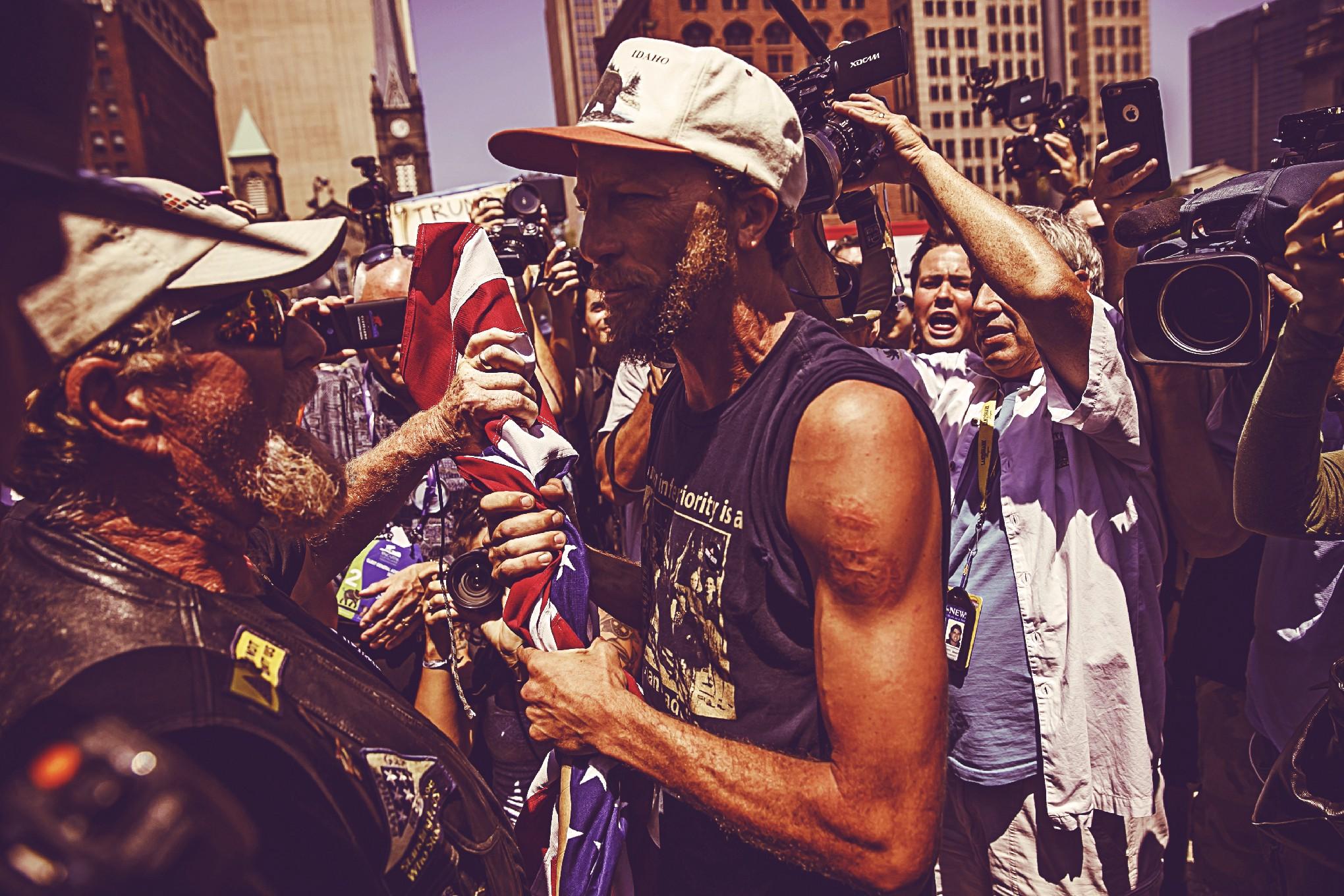The RNC’s Theater of Protest
On the streets with lefties, performance artists, and Bikers for Trump
Cleveland is demanding our attention. From the Republican National Convention to the Cavaliers’ NBA championship, the Indians’ recent dominance to a surprising tech scene, we’re thinking about the city more than ever. This week,The Ringer is exploring why Cleveland matters.
In Cleveland, you learn about street protests not by hearing chants or police sirens but by checking Twitter. On Wednesday afternoon, #wallofftrump was trending. I stepped outside the Republican National Convention perimeter and saw the wall. Protesters had fastened together a bunch of bed sheets and painted them to look like a chain-link fence. Some of the inscriptions said: “No Mas Trumpadas.” The protesters were marching west on Prospect Avenue. I tagged along.
The first man I met was Neptali Perez, a labor organizer from Nashville. Sixteen years ago, Perez came to the United States from Chiapas state in Mexico. This week, he’d hitched a ride from Nashville and said he would protest through Thursday.
Further up the march, I met a protester who would give his name only as Neil. “We’re just doing Neil today,” he said warily, glancing at the cops who were shadowing the protesters on both sides of the street.
The rise of Black Lives Matter was an exciting moment for activism, Neil said. “Any big city that you go in, you’re just tapping into that energy — that national energy,” he explained. “If you study Calculus 1, by the mean value theorem it matches that instantaneous rate of change.”
At the back of the parade was a college student named Dominic Bruno. He was wearing a T-shirt that said ¡Viva Akron! on the front. On the back was Bruno’s title: “Street Medic.” His job was to keep protesters — even counterprotesters who might show — safe from injuries and the heat.
Bruno and I made a right turn at Ontario Street, where we jumped over a police barricade. “It’s been pretty tame, actually,” he said of the protests. “Everyone here seems very chill. The police, they’re out in force.” I glanced behind the parade: at least 30 cops on bicycles followed us, wearing sunglasses and helmet cams. “But the protesters have been real respectful,” Bruno said, “and even the counterprotesters don’t seem to be causing any trouble.”
The marchers filed into Public Square, a park in the shadow of Cleveland’s Terminal Tower, which has been the center of activism this week. And then #wallofftrump sort of … petered out. There were no arrests that I saw, no fiery, culminating speech. A few minutes later, protesters were folding up the bed sheets.
I met Tom Moore, a young protester with curly hair cascading out of his baseball cap. He’d written the number of the National Lawyers Guild on his arm, in case he got arrested. Moore held a sign that read: “CLIMATE DENIERS AND HYDRO-FRACKERS / PERFECT PARTIES FOR A BURNING PLANET.”
Moore was glum. There had been a buzz that the protests here would have the epic scale of those that surrounded the 1968 Democratic National Convention. “That’s what everyone was saying: This is going to be the craziest shit since ’68,” he said. There would be lefties with signs, cops forming cordons, and — playing the role of the Nixonian hard hats — Bikers for Trump.
But the number of activists that turned out? “In a word, underwhelming,” Moore said. He added, “There have been some great rallies. But we’ve had crowds of maybe 500 a few times, you know? Conventions in the past, we’ve been talking about thousands — tens of thousands. That’s really what I was expecting.”
Cleveland’s protest scene hasn’t been without its memorable moments. Nick Cannon appeared at a Black Lives Matter protest here on Monday. Conspiracist Alex Jones claimed he got in a scuffle after he was slugged in Public Square the same day. There has been protest comedy, both intentional (Triumph, the Insult Comic Dog) and not (the Westboro Baptist Church). Trump’s speech Thursday night may yet serve as a magnet for activism.
But as of Thursday morning, protesters felt a disconnect between the ferocity with which Trump’s bigotry and misogyny was being shared on their social media feeds and the number of people who actually hitched a ride to Cleveland. “A lot of outrage all over Facebook,” Moore said. “But apparently a lot of people not quite outraged enough to take the streets.” What happened?

On the corner of Ontario and South Roadway, I met two women in pink outfits. Brianna Halasa is a Smith College student with at least one activist victory under her belt. In 2014, she and her pals engaged in protests that caused International Monetary Fund head Christine Lagarde to pull out of her planned commencement address.
Brianna’s older sister Marni runs a New York group called Revolution Is Sexy. “What I do is combine protest with performance art,” Marni told me. “Often I find that if certain words can’t get into the paper, an image can. So I’m trying to get into people’s consciousness and into their dreams.”
Today, Marni had infiltrated our dreams by wearing a butterfly outfit with giant wings.
“I’m surprised by the number of people that turned out,” Brianna said. “I thought there’d be a little bit more.”
A sense of Midwest nice, they both agreed, hovered over the proceedings. “The Trump supporters here, they’ve got that cool, Midwest groove, that nice thing going,” Marni said. “So we’ve been able to talk.”
Around 7 p.m., before the evening session of the Republican National Convention began, I went back to Public Square to see what was happening. But for the huge number of cops milling around, the scene felt like an ad for the New Urbanism. Bicyclists relaxed on a hill that one cop had ominously called the “grassy knoll.” The city had turned the fountains on, and a few people splashed in the water. This week, downtown Cleveland has largely been empty of office workers — many were told to stay away — and it was the first time you could imagine the city as it is on a normal weekday afternoon.
I met a man named Jamie Taylor, who was wearing a Harley-Davidson baseball cap.
What are you doing here? I asked.
“Just hangin’ out and prayin’, my man,” he said.
Taylor and his associate, Diane Googins, belonged to a group of street evangelists called Hope Is Here. They descended on Cleveland to “just get rid of all this hate towards each other,” Taylor said.
“They started a protest over here,” Taylor told me, pointing to a spot on the north end of Public Square. “We all went down, stood between the cops and them, [and] began to pray …”
Taylor was fuzzy about exactly who had been protesting. A group with a name like “Hate America” or something, he thought. Taylor and Googins and a few friends had wedged themselves between the protesters and the cops. They held hands and prayed for peace. And a funny thing happened, Googins said. “They just started putting everything down and that was it.”
The protesters laid down their signs and were quiet? I asked. It was almost an image out of the Bible.
“I kid you not,” Taylor insisted. “They just began to lay things down and that was it, man.”
In Cleveland this week, I could almost believe it.

The protesters have a few theories about why they didn’t turn out in bigger numbers. One is the fear of violence — an itchiness after the events in Baton Rouge and Falcon Heights and Dallas. “There’s a lot of fear going around,” Tom Moore said. “Donald Trump started it himself with hype about riots and blood in the streets. I think that may have kept a fair number of people away.”
Bikers for Trump emerged as the menacing face of the counterprotest movement. On Monday, I met Christopher Cox, the group’s goateed leader. Cox promised to be the cops’ vigilante sidekick. “The police officer is the last stand of civilization,” he said. When Cox appeared out of nowhere at Quicken Loans Arena to subdue a protester on Monday, it seemed like Bikers for Trump might be a force. But protesters hadn’t seen much of them since. The fear, they thought, was more like a media-created fever dream.
The second theory behind the lack of activism in Cleveland is that there are a crazy number of cops around. There are 5,500 law-enforcement officers in Cleveland — “This is where our tax dollars are going,” Brianna Halasa said — and it can feel like they’re all downtown at once. (Downtown Cleveland stinks — there are piles of manure from the police horses.) Attending the RNC is like attending a Midwestern police convention. When I left the arena Tuesday night, California Highway Patrol officers had joined with Cleveland cops to form a protective gauntlet to allow delegates to exit.
And Republicans — who have made law and order perhaps the biggest theme of the convention — are gracious. “Thanks, California,” one delegate said as he passed a patrolman.
All over downtown Cleveland, you see Calvin Williams, the Cleveland police chief, wearing a crisp white uniform and operating like a general in a theater of war. There he was on East Fourth Street, near the MSNBC set, asking cops on the radio to unclog the road. When Tom Moore and I were talking in Public Square, Moore suddenly cried, “Go home, bigots!” I turned around and saw that the square had been taken over by a religious group with a megaphone.
“God is for walls!” one of them yelled.
As if on cue, Chief Williams appeared. I heard him tell an officer, “Why don’t you put a line right there?” A bunch of cops formed a cordon bisecting Public Square. The religious protesters and a few lefties were isolated on one side. A few minutes later, the cops had moved even closer to the religious protesters, so the two adversaries were effectively separated. Now, there was little chance of violence — we were left with pure theater. On one side, a guy held up a green poster board that read, “Make America Vape Again.” On the other, the right-wingers yelled, “You want tax dollars on your EBT card so you can do nothing! … God will execute justice on you!”
A guy in an Indians cap sidled up to Chief Williams and said, “Free speech is good, but not if you’re saying stupid shit like this.”

Here’s the third and most intriguing theory: This is the wrong place to look for activism. After all, back in ’68 the locus of protest wasn’t Nixon’s GOP conclave in Miami Beach. It was Chicago. “That was a Democratic Convention,” Tom Moore said, “and we’ve got a Democratic Convention coming up. So we’ll see what happens there.” Moore made a vow I heard from just about every protester I talked to. After the RNC, he was going to Philly.

